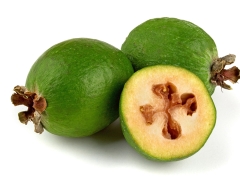From what age do feijoa give children?
In autumn, green feijoa fruits appear on the shelves of many stores. Some adults have never tried it, and those who regretted and managed to love for its pleasant taste, doubt whether it is allowed to give it to children.
Composition and use
Such exotic fruits for many of our compatriots have a pleasant berry-banana taste and a delicate scent, somewhat reminiscent of pineapple and strawberries. Feijoa is from South Brazil, but is now grown in various countries, including Azerbaijan, Armenia, Georgia and southern regions of Russia.
The beneficial properties of feijoa for the body are due to its composition:
- There is a lot of iodine in these fruits, therefore, their use is recommended for thyroid diseases caused by a lack of such an element. In addition, iodine in feijoa is water soluble, due to which its absorption is more active than from pharmacy complexes.
- In addition to iodine, gives the child salts of magnesium, zinc, iron, calcium and potassium.
- Contains a fairly large amount of vitamin C, so that such a fetus protects the child from viral diseases and is useful for immunity.
- Contains ripe fruit riboflavininvolved in metabolic processes. This vitamin has a positive effect on the work of the heart and brain activity.
- It is a source of vitamins B3 and B5, therefore, the use of such a fruit affects the formation of red blood cells, regeneration processes, liver and respiratory organs.
- The composition also has vitamins B6 and PP, therefore, such fruits affect protein metabolism, enzyme synthesis, and the activity of the nervous and cardiovascular systems.
- The fruits contain amino acidsamong which there are irreplaceable.
- Significant amount of pectin in the pulp allows its use against constipation. At the same time, there are a lot of tannins in the peel of the fruit, so its extract can help with diarrhea.
- Due to the presence of many vitamins, iodine compounds and essential oils in its fruits, it is noted antidepressant effect.
- If you give feijoa to small children regularly, this will increase their hemoglobin level and improve the elasticity of blood vessels.. In addition, these berries have the ability to stimulate growth, so they can be given to children with a slight lag from their peers.
Read more about the useful properties in the video:
From what age to give?
For the majority of our compatriots, such fruits are exotic and fall into stores from Armenia, Georgia and other countries. For this reason, feijoa is not advised to give the infant until at least 1 year old. Although the fetus is extremely rare to cause allergies, but occasionally they have an individual intolerance, due to which they are not recommended to include in the diet of babies 6-11 months.
Children older than a year can offer feijoa pulp crushed in a blender. Before its preparation, the fruit is thoroughly washed and the peel is removed, and then mashed potatoes are prepared. Sugar should not be added to it, so that the child can appreciate the natural taste of the fruit.
The first portion should be no more than a teaspoon. If the organism of the baby has transferred it well, the volume of mashed potatoes can be gradually increased. As for how much to eat it per day, then at the age of three years, the restriction will be one berry. When the baby is 3 years old, his diet can be varied jams, sauces, pastries and other dishes with this product.
Harm to the child's body
- If you use the fruit along with dairy products, it threatens indigestion.
- The child is contraindicated to give raw feijoa peel.
- An immature fetus can cause food poisoning.
- Fruits are contraindicated in hyperthyroidism.
- They are also undesirable to include in the diet of children with obesity or diabetes.
How to choose
For baby food, buy dense and elastic fruits with no dents or rotten areas. When cutting the feijoa, make sure that the flesh is no longer white (this color indicates its immaturity). If the insides of the fruit are transparent, "luminous", then it will be tasty and useful. The beige or dark color of the pulp indicates deterioration.
Read more about the benefits in the program "Live is healthy."





























































